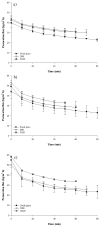Effect of Pectinolytic Enzyme Pretreatment on the Clarification of Cranberry Juice by Ultrafiltration
- PMID: 33466623
- PMCID: PMC7828648
- DOI: 10.3390/membranes11010055
Effect of Pectinolytic Enzyme Pretreatment on the Clarification of Cranberry Juice by Ultrafiltration
Abstract
Cranberries, mainly processed as juice, have garnered interest over the past decade due to their high content of phytochemical compounds related to promising health benefits. To meet consumer expectations, a juice clarification step is usually incorporated to remove suspended solids. The use of pectinolytic enzyme and membrane processes are commonly applied to the production of clarified juices, but no studies have been done on cranberry juice. In this study, the effects of 60 (D60) and 120 min (D120) of depectinization by pectinolytic enzymes coupled to clarification by ultrafiltration (UF) (membrane molecular weight cut-off (MWCO) of 50, 100 and 500 kDa) was evaluated on the filtration performance, membrane fouling and cranberry juice composition. Compared to fresh juice, depectinization for 60 and 120 min reduced the UF duration by 16.7 and 20 min, respectively. The best filtration performance, in terms of permeate fluxes, was obtained with the 500 kDa MWCO UF membrane despite the highest total flux decline (41.5 to 57.6%). The fouling layer at the membrane surface was composed of polyphenols and anthocyanins. Compared to fresh juice, anthocyanin decreased (44% and 58% for D60 and D120, respectively) in depectinized juices whereas proanthocyanidin (PAC) content increased by 16%. In view of the industrial application, a 60 min depectinization coupled to clarification by a 500 kDa UF membrane could be viewed as a good compromise between the enhancement of filtration performance and the loss of polyphenols and their fouling at the membrane surface.
Keywords: clarification; cranberry juice; membrane fouling; membrane molecular weight cut-off; pectinolytic enzyme; polyphenols; ultrafiltration.
Conflict of interest statement
The authors declare no conflict of interest.
Figures


References
-
- Girard K.K., Sinha N.K. Handbook of Fruits and Fruit Processing. Blackwell Publishing Professional; Ames, IA, USA: 2006. Cranberry, blueberry, currant, and gooseberry; p. 369.
-
- MAPAQ Portrait-Diagnostic Sectoriel de la Canneberge au Québec. [(accessed on 12 January 2021)]; Available online: https://www.mapaq.gouv.qc.ca/fr/Publications/Portraitdiagnosticcanneberg....
-
- Khoo C., Falk M. Polyphenols in Human Health and Disease. Elsevier; Amesterdam, The Netherlands: 2014. Cranberry polyphenols: Effects on cardiovascular risk factors; pp. 1049–1065.
Grants and funding
LinkOut - more resources
Full Text Sources
Other Literature Sources
Miscellaneous

